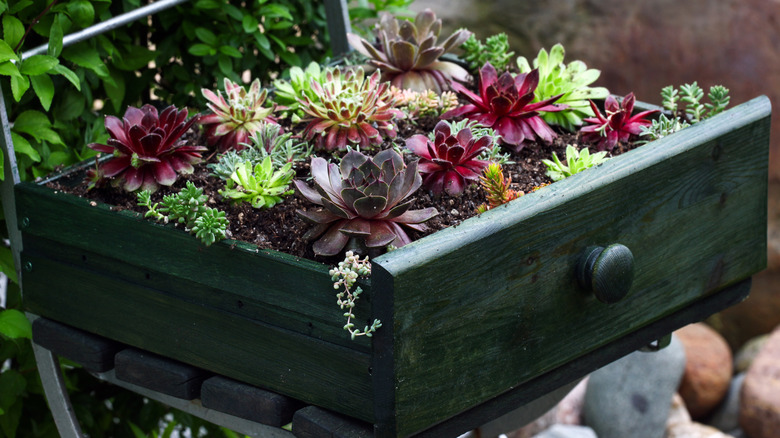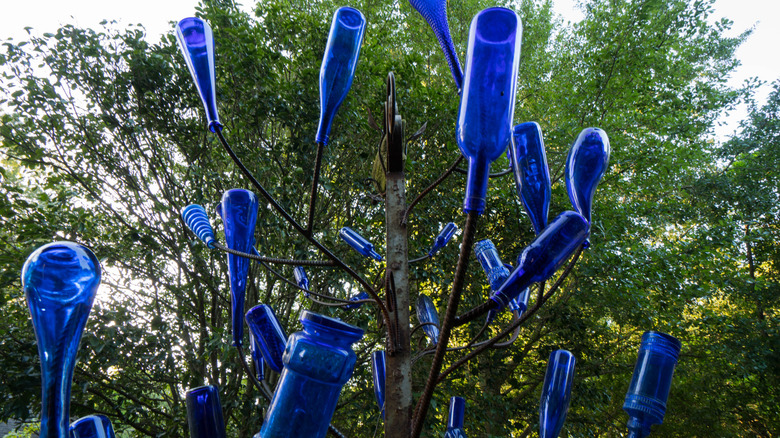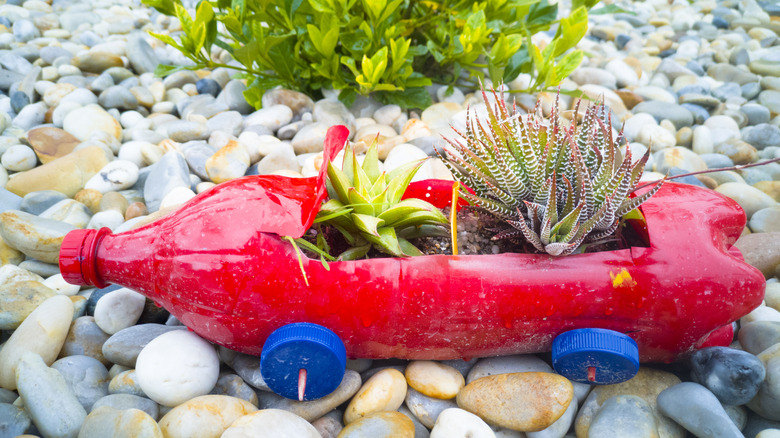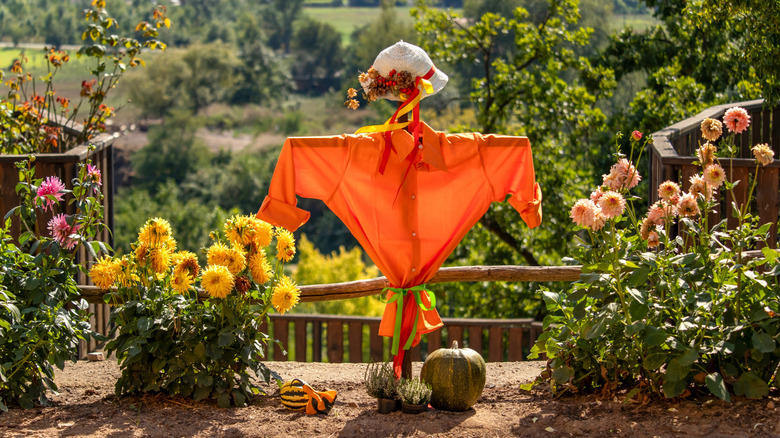Repurpose These Household Staples For Fun And Easy Garden Decor
We may receive a commission on purchases made from links.
Your garden is one of the best places to reuse broken, worn, and mismatched items from your home and garage. Upcycling these objects into garden decor keeps them out of landfills while keeping money in your bank account. When looking for materials to repurpose in your garden, consider sturdy items that won't fall apart the first time they're exposed to rain or wind. Also remember that metal may rust and wooden items are likely to develop a weathered look. When searching for items to upcycle, ask yourself what your garden needs most right now. A trellis to support flowering vines? Signs to label your veggie plants? Comfortable seating? In addition to beautifying your yard, garden decor can serve a purpose for the plants you're growing or the people and creatures that visit them.
If your garden is spacious, it's a prime spot for repurposing furniture. Tables and nightstands that are past their prime for indoor use can have a second life as plant stands and potting surfaces. Or cut them apart and use their tops to make painted signs or raised garden beds. Dresser drawers and old wheelbarrows can be turned into sturdy planters that infuse your garden with personality. You can even DIY a garden trellis from old mattress springs. Spray paint it a trendy color to give your cucumbers the most stylish climbing wall in the neighborhood. Krylon K05528007 indoor-outdoor spray paint and primer is a good option for outdoor projects like this. Looking for smaller pieces of garden decor? Head to the kitchen, where you'll find many materials to upcycle.
Create garden edging with dishware, bottles, or cans
Chances are, some of your landscape edging could use a refresh. Tending to it can help prevent grass from growing in your garden and garden plants from sprouting in your grass. Plus, it creates defined spaces that offer visual appeal. Instead of buying bricks or plastic edging, create borders around your beds with old dishes. China plates work well for this, as do glass tumblers and coffee mugs. Push each dish a few inches into the ground. If there are any chipped edges, put these parts in the soil so they're unlikely to scratch you. Submerging the openings of cups in soil can keep water from collecting inside them and attracting mosquitos. The dishes should be placed close together so they form a mini fence that separates your growing space from your mowing space.
Don't have any dishware to spare? Try thrifting vintage china plates and saucers. Or use disposable items that can handle outdoor conditions. For example, you can make garden edging from old wine bottles, glass jars, or tin cans that have been cleaned and dried. YouTuber @Douglas Welch has a nice example as shown above of a garden border made from wine bottles. If you use cans or jars, consider painting them to add a pop of color to your landscape. After painting, add a coat of sealant to help your edging stay vibrant. Krylon K01309 Artist Series aerosol clear coating resists both moisture and ultraviolet rays.
Make birdbaths and mushroom statues with old bowls
Old and mismatched glassware isn't just for edging. You can turn it into an adorable mushroom statue. Find a spare bowl and flower vase, or pick up these items at a thrift shop. Also get some vase filler beads — a 1-pound bag of Fantian glass pebbles, for example. Want your sculpture to light up? Grab fairy lights such as the Aozope 6-pack of battery-operated LED twinkle lights. Place the beads and a string of lights in the vase. Then turn the bowl upside down and hot glue it to the top of the vase. Voila! You've got an illuminated mushroom. For a visual of the final product, watch the above video from TikTok user @violentmoonrising.
If you'd like to make something more functional from old dishes, a birdbath is a fine choice. When filled with water, it's likely to draw finches and other birds that can help your garden thrive by eating insects, weed seeds, or both. Locate a large, shallow dish and something you can use as a pedestal — say, a heavy cake stand. Stick them together with weather-resistant glue such as Gorilla Max Strength waterproof adhesive, fill your creation with water, and see what kinds of visitors it attracts.
Upcycle glass bottles into garden sculptures
Glass bottles can be repurposed in your garden in a host of ways. If you have some that are an attractive color — for example, cobalt blue — consider turning them into a bottle tree. You can use an old tree branch, pitchfork, or coat rack as the base. Slide the bottles' openings over the branch ends, tines, or coat pegs, whatever the case may be. Then, push the tree into the ground as you would a shepherd's hook. If these materials aren't available, you can make eye-catching bottle art with metal rods. Find rods of different heights, push them into the ground, and top each with a bottle.
Have some beer or wine bottles to spare? Turn them into plant markers. Use weather-resistant paint to label each one with the name of a plant you're growing. You could also paint leaves or flowers on the bottles. Each bottle's neck acts as a stake for your garden sign. Just push it into the soil and enjoy the flair it brings to your landscape. Or, for something entirely different, turn your wine bottles into cheery bird feeders.
Turn plastic bottles into whimsical planters
If you drink soda or bottled water, you probably have some plastic bottles on hand. These make great little planters that you can customize to reflect your design style or sense of whimsy. Have some small plants that look like they need a convertible ride? Coat a bottle with weather-resistant paint and cut an opening in the side, leaving a flap of plastic on the side closest to the bottle's neck. Bend the flap so it looks like a windshield. Then attach four bottle-cap "wheels" with toothpicks or waterproof glue. Fill your mini planter with soil, a driver, and possibly a rider in the backseat. Place it in a spot that's shielded from wind but ideal for a joyride.
You can also turn a plastic bottle into two hanging planters. Wash the bottle and screw on the cap. Then cut the bottle in half and paint the exterior and interior of each piece. Once the paint has dried, grab the half with the cap and wrap twine around the cap and neck. Secure the twine with glue to keep it from detaching over time. Then poke two holes in the plastic with a knife or sewing needle. They should be about a half an inch below your container's lip, directly across from each other. Add two holes to the other container as well. Then guide twine through the holes to create hangers for your new planters. After filling them with potting soil and plants, hang them from a tree in your garden.
DIY a scarecrow using old clothes and broomsticks
Have some clothes that don't fit and some accessories that have seen better days? Turn them into a scarecrow that can frighten rabbits and large birds away from your garden. Start by making a frame out of two old broomsticks or long, straight branches. Nail the pieces together so they look like a lowercase t. The nub at the top can hold your scarecrow's head, which might be a pumpkin or a burlap sack filled with grass clippings. If you'd like, draw a face on the head with permanent markers and make some wild hair out of vines or corn silk. Or simply dress up the nub with a hat. To help the hat stay put on windy days, attach it to the frame with a nail, a heavy-duty staple, or weather-resistant glue.
Once your scarecrow's head is ready for prime time, outfit the frame with clothing. The arms of a shirt, jacket, or dress should fit on the crossbar. To make scarecrow dressing as easy as possible, choose a button-down garment. You can use nails, glue, or string to secure the clothing to the frame. Consider adding aluminum foil to your scarecrow's outfit, too. This can make your scarecrow scarier to crows. Or give your scarecrow a bag to carry. You can fill the bag with soil and use it as a small container garden. Line the bag with plastic, cut drainage holes in its bottom, and then add potting soil and plants. Your scarecrow will be glad to hold flowers or a small collection of succulents.



